The Venus flytrap is the best known carnivorous plant out there. It has been featured in countless science fiction movies, series, and books. Since its discovery, it has amazed scientists and aficionados alike. Charles Darwin even described it as the “most wonderful plant in the world.”
I have grown Venus flytraps and other carnivorous plants in my home for several years, and I always like learning more about them. Today, I have put together some very curious and unique facts about these amazing plants.
Even though most people have heard about Venus flytraps, very few actually know some facts about these fascinating plants. With this in mind, I have created a list of some curious Venus flytraps facts:
- Venus flytraps are an endangered species
- Venus flytrap can digest meat
- They are native to North and South Carolina
- Red Venus flytraps exist, and they are beautiful
- Their most common meal is not flies
- They are the state carnivorous plant for North Carolina
- Venus flytrap produce white flowers
- Venus flytraps do not consume pollinators
- There are over 50 varieties of Venus flytrap
- Venus flytraps choose their prey carefully
- Prey trapped inside a Venus flytrap dies by drowning
- Venus flytraps can make great indoor plants
- Venus flytraps lure prey with sweet nectar and bright colors
- Tap water kills Venus flytraps
- Venus flytraps do not need bugs to survive
- Their trapping mechanism is extremely advanced
- Fertilizers can kill Venus flytraps
- Venus flytraps can reduce bug populations indoors
- Venus flytraps are harmless to humans
- They change colors according to their needs
- Venus fly traps can propagate through 5 different paths
- They open their traps in a concave or convex shape (and it has a meaning)
- Poaching is the biggest threat for Venus flytraps
Learn more about each fact with this complete list
1- Venus flytrap can digest meat
Venus flytraps are carnivorous plants, not insectivorous plants. They can consume meat. Even though it is unusual, large plants can capture small birds, rodents, or frogs. In the wild, any animal small enough to fit inside a trap can be a potential victim. For example, mature traps surpass a length of one inch and dozens of tiny frog species can fit in that space.
The digestion process for Venus flytraps is very slow. They take several days or even weeks to digest a single bug. When this plant attempt to digest more complex organism, such as frogs, the digestion process is more challenging. The plant will have the capacity to break up the soft parts of the victim but will leave the skeleton behind.
2- Red Venus flytraps exist, and they are beautiful
Red Venus flytraps are known as Akai Ryu, which means “Red Dragon” in Japanese. This Venus flytrap variation has a unique color. The inside and outside of the leaves are maroon or purplish-red.
Akai Ryu is a Venus flytrap cultivar. Which means, this variation of Venus flytraps does not grow in the wild, humans have developed it.
“Through breeding efforts in the support greenhouses of the Atlanta Botanical Garden, a new all red form of the Venus Flytrap (Dionaea muscipula) has been created.” (Ron Gagliardo, A New Cultivar of Dionaea muscipula Ellis, Carnivorous Plant Newsletter)
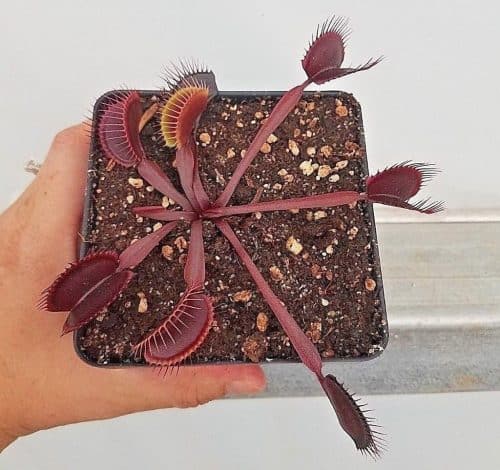
3- Venus flytraps are native to North Carolina and South Carolina.
Some might imagine Venus flytraps growing in tropical jungles or savannahs. But, Venus flytraps are only native to two states in the United States: South Carolina and North Carolina. There, these plants grow with an abundance of sunlight in very humid and nutrient-free terrain. Also, Venus flytraps are resilient plants, in the Carolinas they can withstand hot summers that commonly surpass 90 F and temperatures below freezing in the winter. Besides, these plants require a temperature change through the seasons. During the winter, they experience dormancy through the cold season and they reflourish in the spring.
4- The most common meal for Venus flytraps is NOT flies
Venus flytraps eat several different types of insects and arachnids. They consume, for example, crickets, beetles, grasshoppers, spiders, slugs, ants, worms, and of course, flies. As long as the bug is small enough to fit in a trap, the Venus flytrap will most likely be able to capture it.
The popular belief that Venus flytraps are solely designed to capture flies is incorrect. Actually, in the wild, Venus flytraps not only enjoy a varied diet, but their main victims are usually ants and crawling insects.
5- Venus flytraps are an endangered species
A few years ago, the Venus flytrap was added to the endangered species list. Their original habitat has been changing due to an increase in urbanization and agricultural development. Also, the presence of poachers has reduced the plant population living in the wild. Poachers extract Venus flytraps from their habitat and sell them for profit.
If you ever encounter a Venus flytrap outdoors, do not attempt to remove it. Also, if you are planning to buy one, make sure you are buying from a responsible nursery or vendor. We must all wok together in preserving this fascinating specie of carnivorous plants.
6- North Carolina selected the Venus flytrap as its state carnivorous plant
North Carolina is the first and only state in the United States to select a state carnivorous plant. Since 2005, their state carnivorous plant is the Venus flytrap. This initiative aims to promote the conservation of the species.
Also, since 2014 poaching Venus flytraps have evolved to been considered a misdemeanor to a felony in the state of North Carolina. It is a serious crime to harm the species.
7- Venus flytraps produce flowers
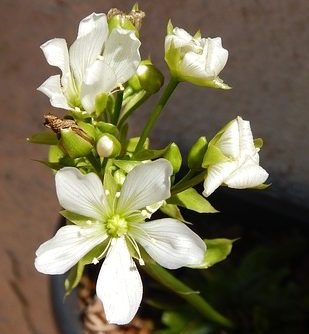
Most people have heard about the Venus flytrap and are familiar with the traps. Yet, very few are aware that Venus flytraps grow flowers. The traps in Venus flytraps are not flowers, they are simply modified leaves that evolve to capture bugs.
During spring, Venus flytraps produce several flower stalks. The flower stalks grow to become flower bunches.
The flowers are white, and they have green veins running through the petals. The flowers are not very impressive. Still, Venus flytrap growers can fertilize them and harvest seeds.
8- Venus flytrap do not consume bug pollinators
Venus flytrap employs a smart mechanism to avoid consuming pollinators. Venus flytrap flowers grow over their traps. As shown in the picture below, the leaves extend only a few inches above the ground, but the flowers grow a lot higher. Venus flytraps evolved to keep prey and pollinators at two different levels.
“Of the roughly 100 different species that visited the plants, only a few were effective pollinators. These included green sweat bees, checkered beetles, and notch-tipped flower longhorn beetles, all of which were found on the plants but not in their traps.” Venus Flytraps Have Surprising Pollinators … and They Don’t Eat Them
, Elaina Zachos, National Geographic
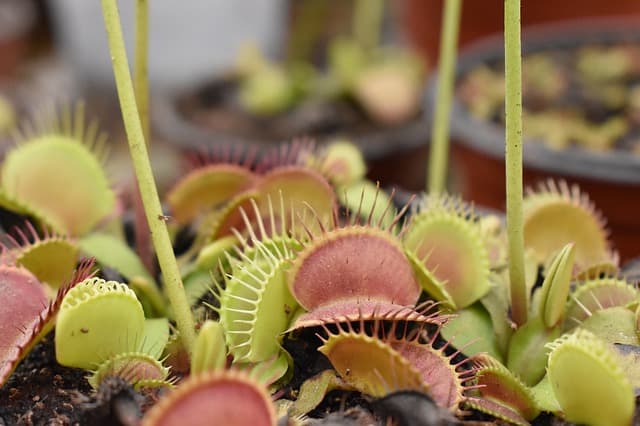
9- Over 50 Venus flytrap variations exist
Scientists and experience carnivorous plant growers have experimented with Venus flytraps for decades. At this time, they have created dozens of different variations of Venus flytraps. The Akai Ryu variation explained above is not the only one. Here are some famous Venus flytrap cultivars:
- Dionaea Green Dragon: These plants look very similar to the red Venus flytrap. but they are not completely red. The edges of the lobes exhibit a bright green color.
- Dionaea Sawtooth: This Venus flytrap exhibits short cilia in the traps. The cilia is usually compared to a saw or shark teeth.
- Dionaea Gremlin: This variation is a completely green Venus flytrap. There are no signs of red coloring inside the lobes.
- Dionaea Ginormous: This cultivar is one of the largest Venus flytrap specimens. The traps can surpass the two inches long.
- B-52 Giant Venus flytrap: Another large specimen of Venus flytrap.
This variations, do not grow in the wild, they have been produced in a controlled environment and can be sold commercially for recreational purposes. I personally own the B-52 Venus flytrap clone. In overall dimensions the plant is still not huge. But the traps are massive compared to standard Venus flytraps.
10- Venus flytraps choose their prey carefully
The process of catching and digesting prey takes significant amounts of energy from the plant. Therefore, Venus flytraps must choose victims carefully before starting the process.
First, the plant must verify it has caught live prey. Venus flytraps detect motion through trigger hairs inside their traps. If the plant can’t detect movement after it has caught prey, it will reopen. A leaf, stick, or any other inanimate object could have activated the trapping mechanism.
Also, Venus flytraps test the size of the prey they caught before they consume it. When the trap closes, it doesn’t do it in one single stage [1]. First, it goes into a semi-close stage. If the victim is a tiny insect, it will be able to scape at this moment. During the second stage, the trap will close shut and start the digestion process.
“Among carnivorous plants, the Venus flytrap is of particular interest for the rapid movement of its snap-traps and hypothesized prey selection, where small prey are allowed to escape from the traps (…) ” Understanding the Venus flytrap through mathematical modelling
, Sami Lehtinen
11- The prey trapped inside a Venus flytrap dies by drowning
Venus flytraps digest their prey by secreting enzymes inside the trap. Once the plant has caught a bug in one of its traps, the trap will close hermetically. Then, special glands will produce enzymes that fill the trap and cause the victim to drown.
Digestion for Venus flytraps is a very long process. The plant takes several days or even weeks to consume a single insect.
12- Venus flytraps can make great indoor plants
You can be a Venus flytrap owner in no time! Regardless of where you live and the weather considerations, you can own a Venus flytrap, because these plants are fine indoor plants.
Venus flytraps need plenty of water, tons of light, and nutrient-free soil to live. Building a good environment to grow Venus flytraps indoors in reasonably easy. The only element that could be a challenge indoors is lighting. Venus flytraps require 4-12 hours of light a day.
It is not rare that homes or apartments lack a spot with good sunlight. Yet, there is an easy fix. You can buy a high output fluorescent plant light. Even without any windows, you can grow Venus flytraps indoors, thanks to artificial lighting.
13- Venus flytraps lure prey with sweet nectar and bright colors
Nectar secreting glands inside the traps produce sweet nectar to attract prey. Insects are attracted to the nectar and the bright red color inside the traps. Bugs get confused and believe the red interior of the trap and the nectar scents are the clear signs of a flower.
Flying and crawling mechanisms are commonly attracted by Venus flytraps. However, the plant has a better success rate with crawling insects that walk inside the trap consuming the nectar.
14- Tap water is poison for Venus flytraps
In the wild, Venus flytraps live in a nutrient-free environment. These plants have evolved to survive without substantial nutrients from water or the soil. As a result, they can’t handle nutrients in the ground or water.
Venus flytrap owners can’t water their plant with tap water. Tap water has minerals and added elements. Instead, they can use distilled water, reverse osmosis water, or rainwater. Bottled water is also unsuitable for carnivorous plants, as it contains minerals for flavor.
You can learn more information about the plant watering requirements and other care considerations by reading this article: Venus Flytrap Care Guide . The content is very useful for prospective Venus flytrap owners and novice growers.
. The content is very useful for prospective Venus flytrap owners and novice growers.
15- Venus flytraps do not need bugs to survive
One unique characteristic of plants is that they can produce their own food. They make their food through photosynthesis. And, the Venus flytrap is not an exception.
During photosynthesis, plants utilize sunlight to synthesize food from carbon and water. Venus flytraps catch bugs with their traps and digest them with enzymes, but they consume insects as a supplement to their diet (due to the lack of nutrients in their habitat).
Venus flytraps live thanks to photosynthesis. Yet, the Venus flytrap’s habitat lacks nutrients. Without crucial nutrients in the soil, their diet is not balanced. Venus flytraps consume bugs to extract elements such as Nitrogen, Phosphorus, and Potassium. These elements supplement their diet. Still, photosynthesis produces its source of fuel. Venus flytraps can survive without bugs. Yet, the plant won’t thrive without catching an occasional insect.
You can find a more in-depth explanation about the feeding requirement and effects in this article .
.
16- The trapping mechanism in Venus flytraps is one of the most advanced in the plant kingdom
There are several different types of carnivorous plants, such as pitcher plants, sticky leaf plants, and snap traps. The snap trap mechanism is a living proof of successful evolution.
The environment where Venus flytraps grow is very poor in nutrients. Very few plants are able to survive in that environment. The Venus flytrap was able to thrive in such a habitat thanks to becoming a successful predator. Here are a few interesting details about the mechanism:
- Double stimuli mechanism: The lobes in each trap contain trigger hairs. The trap only closes if the hairs receive stimuli twice within a short period. The dual stimuli mechanism prevents the plant from closing due to rain, dust, leaves, or any inanimate object.
- The trap can reopen: When the plant has capture prey, the leaves do not close airtight right away. First, they go into a semi-closed state. The plant needs to confirm it has caught live prey before it starts digestion.
- The traps close fast: The trapping mechanism of Venus flytraps is one of the fastest movements observed in the plant kingdom. At a resting stage, the lobes within the trap are in a convex position. After appropriate stimuli, they flip to a concave position. This method allows the plant to close its traps in a fast and decisive manner.
17- Fertilizers are gold for most plants, but they weaken Venus flytraps
Fertilizing is a must for most plants. But, Venus flytraps are a curious exception. Venus flytraps struggle synthesizing minerals and nutrients from the environment. Fertilizing a Venus flytrap can end up killing, especially if applied to a young plant or a seedling.
Expert carnivorous plant growers can experiment with weak foliar fertilizers. But amateur growers stay away from fertilizers at all time. Feeding bugs to a Venus flytrap is analogous to fertilizing. So, most people just focus on feeding the plant rather then fertilizers.
18- Venus flytraps can control the bug populations indoors
One of the big pros of owning a Venus flytrap and placing it in your home is that it can help you control the bug population. Depending on the size of the plant, Venus flytrap can consume small insects such as gnats and ant, att the way to crickets and caterpillars.
A single Venus flytrap can not help you exterminate a plague at home. But will definitely help you get rid of the occasional bug rooming around. Venus flytraps are small plants and they usually have 5-10 leaves at a time, which means it can catch five bugs at a time.
Other carnivorous plants are also as effective or even more effective in controlling the insect population. For example, carnivorous plant adhesive traps are highly effective. The butterworts and sundews are some examples of such carnivorous plants.
19- Venus flytraps are harmless to humans and they are even edible!
Venus flytraps can’t harm humans with their traps. Venus flytraps have evolved to capture insects, but not larger animals. Due to their size, the closing leaves in Venus flytraps, can’t harm humans, even if you stick your pinky in. The real truth is that a human will barely feel the pressure of a Venus flytrap closing in their fingers. In the end, Venus flytraps do not use their trapping mechanism to chew on their victims, but to entrap them.
Also, as a parent or a pet owner, you might be wondering if such an exotic plant like Venus flytrap is dangerous. Venus flytraps are not poisonous to humans or some of our beloved pets such as cats and dogs. The plant is considered to be edible and does not possess any risk to own. If a curious pet or children decides to experiment with the plant, the Venus flytrap won’t harm them.
Technically, Venus flytraps are an edible plant for humans, as they do not produce harmful toxins. Still, I am sure you can find a better source of food!
20- Venus flytrap change colors according to their needs
Traditionally Venus flytraps exhibit bright green and maroon colors in theirs leaves. But, sometimes the plants change in color due to the environment. Here are some interesting examples:
- Completely green leaves: When Venus flytraps do not receive enough light. They can lose the red color inside the lobes completely. The change to green is the plants’ mechanism to focus on photosynthesis. The main priority for Venus flytraps is always photosynthesis, then capturing bugs.
- Bright red lobes: The interior of the lobes in Venus flytrap only exhibit bright red colors, when the plant is receiving plenty of light. The reddish colors are a sign that the plant is receiving enough light for photosynthesis and now it is focusing on capturing prey.
- Black leaves: When leaves in a Venus flytrap wither, they turn to a dark black color as they dry up. The black leaves are normal within the plant, as old ones wither and new ones spur. Still, the dark color is quite unique.
21- Venus fly traps can propagate over 5 different paths
You can propagate Venus fly traps through seeds, root divisions, leaf pullings, flower stalk propagation and tissue culture. With a single plant, you can produce dozens of Venus fly trap seedlings.
Personally, my favorite method is leaf pullings. You simply remove leaves from the plant ensuring you include a piece of the root bulb. Then you burry the root area of the pulling. The leaves will eventually grow roots and produce clones of the parent plant.
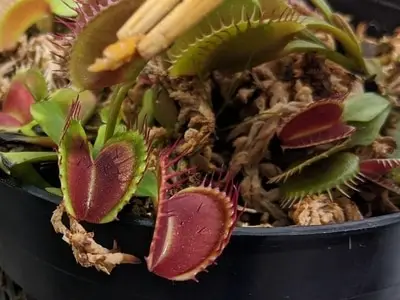
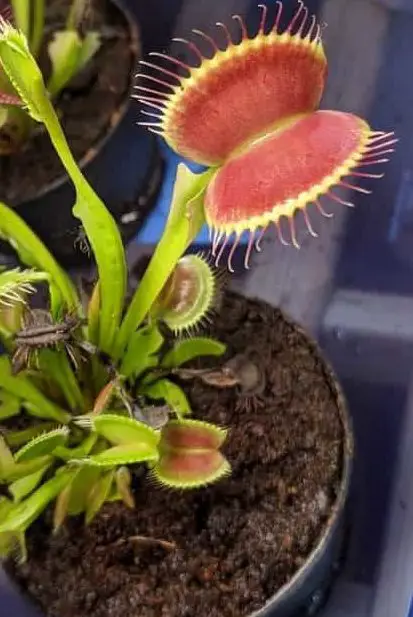
22- They open their traps in a concave or convex shape
Venus fly traps keep their traps open awaiting any insects to become prey.
When a leaf is young, the trap will have a concave shape with enough space for small insects to fly or crawl in. As the leaf matures and fulfill its duty to capture insects, it will then start to decay.
As part of the leaf aging process, the trap will become convex rather than concave. In many cases, convex shaped traps stop working altogether.
The convex shaped traps are still helpful for photosynthesis but they might be able to capture insects.
23- Poaching is the biggest threat for Venus flytraps
Venus fly traps are an endangered specie. They are only native to a small part of the United States, in North Carolina and South Carolina.
Unfortunately, one of the biggest threads affecting the Venus fly trap development in the wild is poaching. People of groups remove Venus fly traps from their natural habitat and sell them.
Poaching Venus fly traps is punishable by law, still, it is a common practice unfortunately.
Avoid buying poached Venus fly traps by inspecting the soil. Smooth soil is a good sign vs diet full of debris and rocks can be a red flag. Also, look at all the available plants, are they uniform in size? uneven Venus fly traps are another red flag.
Final Thoughts
The Venus flytrap is a fascinating yet mysterious plant. I have shared with you several facts about Venus flytraps. But, still, many aspects of this plant remain a mystery. Scientists are actively studying them to understand better its trapping mechanism, evolutionary trends, and functions.
I hope you enjoyed learning about Venus flytraps! Make sure to comment below with questions or other Venus flytrap facts you would like to share with us.
